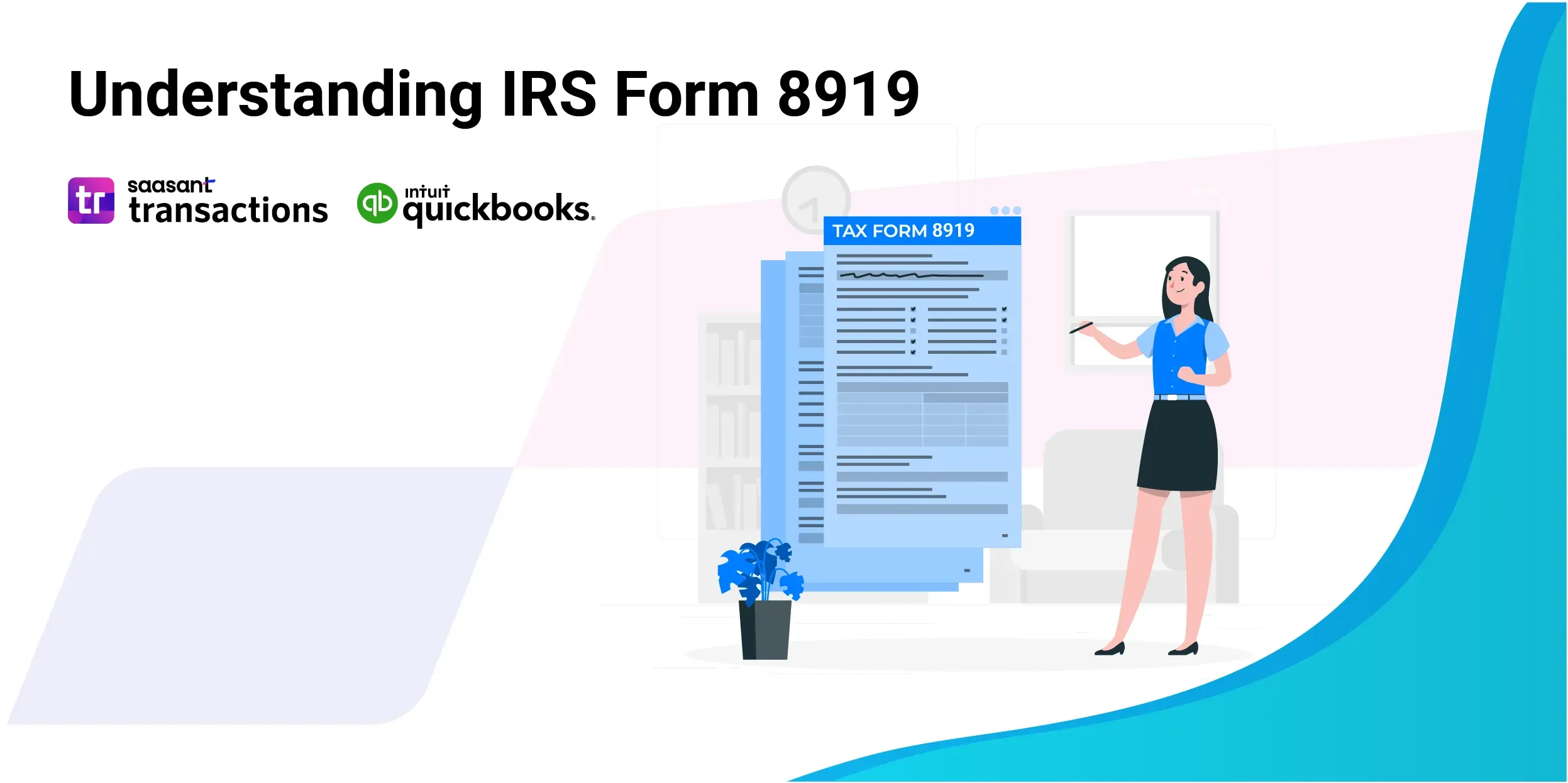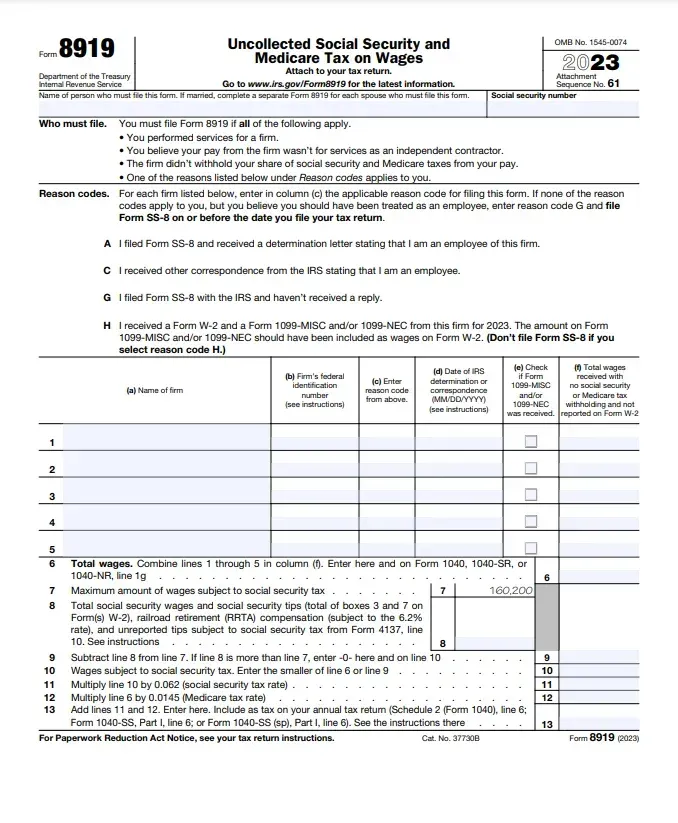Understanding IRS Form 8919: A Comprehensive Guide

Form 8919, a document issued by the Internal Revenue Service (IRS), plays a crucial role in the U.S. tax system. It's essential for workers who believe they have been misclassified as independent contractors instead of employees by their employers. Understanding Form 8919 is vital as it can significantly impact your tax obligations and benefits.
Contents
What is Form 8919?
Who Needs to Use Form 8919?
What Makes a Worker an "Employee"?
When to Use Form 8919
How to File Form 8919
How to Complete Form 8919
Common Mistakes and How to Avoid Them
The Impact of Misclassification
The Consequences of Not Filing Form 8919
FAQs
What is Form 8919?
Form 8919, also known as "Uncollected Social Security and Medicare Tax on Wages," is used by workers who were not treated as employees by their employers but believed they should have been. The purpose of Form 8919 is to calculate and report the employee's share of uncollected Social Security and Medicare taxes due on their compensation.

Who Needs to Use Form 8919?
Individuals should use Form 8919 who have received wages from an employer who did not withhold Social Security and Medicare taxes and meet specific IRS criteria. For instance, if you received a Form 1099-MISC instead of a Form W-2 and your employer did not withhold these taxes, you may need to file Form 8919.
What Makes a Worker an "Employee"?
The distinction between an independent contractor and an employee is not always clear-cut. Several factors determine a worker's status, including the degree of control the employer has over the worker's tasks, the financial aspects of the worker's job, and the nature of the relationship between the worker and employer.
When to Use Form 8919
Individuals should use Form 8919 when they believe they are misclassified as independent contractors. This form is typically filed alongside the tax return. If you're unsure about your employment status, you can file Form SS-8, "Determination of Worker Status for Purposes of Federal Employment Taxes and Income Tax Withholding." The IRS will determine your employment status.
How to File Form 8919
Filing Form 8919 correctly ensures that your Social Security and Medicare taxes are accurately reported. Depending on your circumstances and the specific requirements of the IRS for the tax year in question, you have two options: electronic filing or mailing a paper form.
Electronic Filing
Electronic filing, or e-filing, is a convenient and secure way to submit your Form 8919. You can e-file Form 8919 through various IRS-approved tax preparation software, many of which provide step-by-step guidance to help you fill out the form correctly. E-filing also allows you to receive confirmation from the IRS that your form has been received, giving you peace of mind that your form has been submitted successfully.
Mailing a Paper Form
If you prefer to file a paper Form 8919, you can mail it to the IRS. The specific address to which you should send the form depends on your residence and can be found in the instructions for Form 8919 provided by the IRS.
Ensuring all information is accurate and legible when mailing your form is vital. Double-check all calculations and make sure you've filled out all necessary fields. Also, remember to sign and date the form before mailing it.
Regardless of your chosen method, submitting your form on time is essential. The deadline for filing Form 8919 is typically the same as the deadline for filing your income tax return, which is usually April 15th. If you fail to file on time, you may face penalties, including fines and interest on unpaid taxes.
Avoiding Potential Penalties
Accuracy and timeliness are essential when filing Form 8919. Errors can lead to delays in processing, and you may be required to pay additional taxes or penalties. To avoid these issues, seek help from a tax professional.
Whether you choose to e-file or mail your Form 8919, it's essential to understand the process, follow the IRS's instructions carefully, and ensure that your form is accurate and submitted on time.
How to Complete Form 8919
Completing Form 8919 involves providing detailed information about your employment situation and calculating the Social Security and Medicare taxes that should have been withheld from your wages. Here's a step-by-step guide on how to fill out each section of the form:
1. Personal Information: At the top of the form, you must provide your name and Social Security number.
2. Firm Information (Lines 1-5): For each firm you worked for, you'll need to provide the following information:
Column (a): Enter the name of the firm you worked for. If you received Form 1099-MISC and 1099-NEC from the firm, enter the firm’s name exactly as it is on the form.
Column (b): Enter the firm's federal identification number, which can be an employer identification number (EIN) or a social security number (SSN) if the firm is an individual. If you don't know the firm's federal identification number, you can request it from the firm using Form W-9. If you are unable to obtain the number, enter "unknown."
Column (c): Enter the reason code for why you are filing this form. The reason codes are listed on the form and include situations such as having filed Form SS-8 and received a determination letter stating that you are an employee of the firm.
Column (d): Enter the date of the IRS determination or correspondence if applicable.
Column (e): Check this box if you received Form 1099-MISC and 1099-NEC from the firm.
Column (f): Enter the total wages received with no social security or Medicare tax withholding not reported on Form W-2.
3. Total Wages (Line 6): Combine the total wages from lines 1 through 5 in column (f) and enter the total here.
4. Calculating Social Security and Medicare Taxes (Lines 7-13): In this section, you'll calculate the amount withheld for Social Security and Medicare taxes from your wages. You'll need to know the maximum amount of wages subject to Social Security tax for the tax year (provided on the form), the total Social Security wages and tips you received, and the Social Security and Medicare tax rates (also available on the form).
Remember, completing the form accurately and submitting it on time is essential to avoid potential penalties. If you need clarification on any part of the form, consider seeking help from a tax professional or the IRS. Ensure that you read the general and specific instructions provided in the form before you begin to complete the form.

Common Mistakes and How to Avoid Them
Accurately filling out Form 8919 is crucial to avoid potential issues with the IRS. Here are some common mistakes people make when filling out Form 8919 and how to avoid them:
Incorrect Reason Codes
Form 8919 requires you to provide a reason code that explains why you're filing the form. These codes are listed on the form and correspond to different situations, such as having filed Form SS-8 and received a determination letter stating that you are an employee of the firm. One common mistake is using the incorrect reason code. To avoid this, carefully review the list of reason codes on the form and choose the one that best fits your situation.
Incorrect Calculation of Uncollected Social Security and Medicare Taxes
Another common mistake is incorrectly calculating the amount of uncollected Social Security and Medicare taxes. This calculation can be complex and requires you to know the total wages subject to these taxes, the entire Social Security wages and tips you received, and the Social Security and Medicare tax rates. To avoid errors, carefully follow the instructions on the form and consider seeking help from a tax professional if you need help.
Incorrect Personal or Firm Information
Providing incorrect personal or firm information can also lead to issues. This information includes your name, Social Security number, the name of the firm you worked for, and the firm's federal identification number. Double-check all of this information before submitting the form to ensure accuracy.
Failing to File on Time
Form 8919 should be filed by the tax return deadline, typically April 15th. Failing to file on time can result in penalties, including fines and interest on unpaid taxes. To avoid this, start the process early and submit your form before the deadline.
Not Seeking Professional Help When Needed
Form 8919 can be complex, and it's easy to make mistakes if you're unfamiliar with tax forms. If you need clarification on any part of the form, consider seeking help from a tax professional. They can provide guidance and help ensure that your form is filled out correctly and submitted on time.
Remember, addressing these issues head-on is always better than ignoring them. The IRS provides resources to help, and professional tax advisors can offer guidance tailored to your situation.
The Impact of Misclassification
Being misclassified as an independent contractor instead of an employee can have significant tax implications. Independent contractors are responsible for paying Social Security and Medicare taxes, while employees share this cost with their employers. By using Form 8919, workers who believe they have been misclassified can rectify this and potentially reduce their tax liability.
The Consequences of Not Filing Form 8919
If you fail to file Form 8919 when necessary, you may face penalties from the IRS. These can include fines and interest on unpaid Social Security and Medicare taxes. In addition, your Social Security benefits could be affected, as your earnings may need to be accurately reported to the Social Security Administration.
Form 8919 is a critical document for workers who believe their employers have misclassified them. Understanding this form and when to use it can help ensure you meet your tax obligations and take advantage of any benefits you're entitled to. If you need more clarification about your employment status or how to fill out Form 8919, consider seeking professional help.
Remember, addressing these issues head-on is always better than ignoring them. The IRS provides resources to help, and professional tax advisors can offer guidance tailored to your situation. Review any changes to Form 8919 or its instructions to ensure you know your tax obligations.
FAQs
1. What is Form 8919?
Form 8919 is used to calculate and report your share of the uncollected Social Security and Medicare taxes due on your compensation if you were an employee but were treated as an independent contractor by your employer.
2. Who should use Form 8919?
If you performed services for a company as an independent contractor, but the IRS considers you an employee, and Social Security and Medicare taxes were not withheld, you should use Form 8919.
3. How do I fill out Form 8919?
To complete Form 8919, you must provide your personal information, details about your employer, and the wages received. Based on these wages, you will then calculate the uncollected Social Security and Medicare tax.
4. What is the purpose of Form 8919?
The purpose of Form 8919 is to calculate and report your share of the uncollected Social Security and Medicare taxes due on your earnings if you were an employee treated as an independent contractor by your employer.
5. What happens if I am misclassified as an independent contractor?
If you were misclassified as an independent contractor when you should have been classified as an employee, you could use Form 8919 to calculate and report your share of the uncollected Social Security and Medicare taxes. Using Form 8919 can be an effective way for misclassified workers to save money on their tax bills.
6. What should I do if I received a 1099-MISC or 1099-NEC when I expected a W-2?
If you received a 1099-MISC or 1099-NEC when you expected a W-2, it might mean you were misclassified as an independent contractor. In this case, you can use Form 8919 to report the uncollected Social Security and Medicare taxes on your wages.